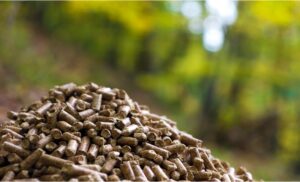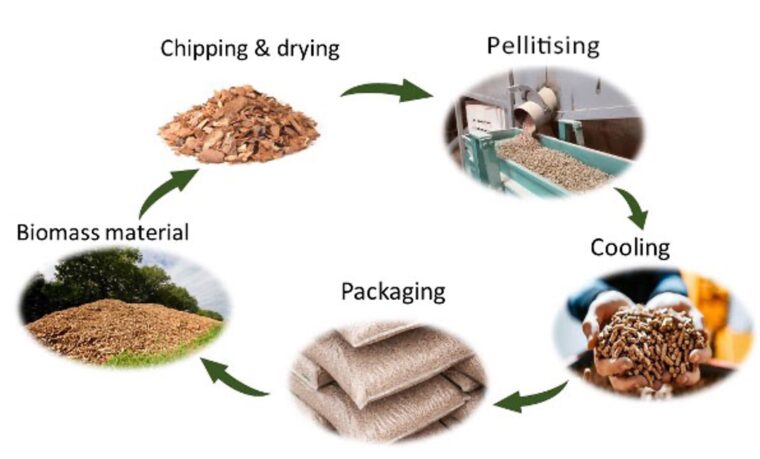Biomass Pelletisation: Influence of biomass characteristics on pellet quality
Take home messages:
- Biomass pelletisation is the process of condensing biomass material into energy-dense pellets by forcing the biomass material under high pressure and temperature through a pellet mill to produce small cylindrical pellets.
- Biomass pellets have uniform size and shape, high bulk and energy density, and low moisture content, all contributing positively to the supply chain management and logistics cost.
- The quality and characteristics of biomass pellets are determined based on key parameters such as the type of biomass feedstock, moisture content, particle size, binding material, pressure, and temperature.
- A high-quality pellet should be dry, hard, durable, and with low ash content. The ENplus certification scheme outlines pellet properties and related threshold values.
Introduction
The global demand for biomass is increasing in response to the need to reduce dependency on fossil fuels, concerns about environmental problems related to its use, and the increasing desire to mitigate climate change. Biomass raw materials are widely regarded as a significant renewable energy source and an alternative to fossil fuels. However, there are limitations with the use of biomass feedstock in its natural form for energy conversion systems. Biomass feedstocks are bulky, have low bulk density, non-uniform properties, low energy density, and high storage, handling, and transport costs. One way to overcome the limitations is using densification to convert biomass feedstock into pellets before use for energy purposes.
Biomass pellets are biomass materials compressed into high energy dense pellets, characterised by; homogenous shape and size, low moisture content, higher bulk density, thus reducing the storage, handling and transportation cost and lower environmental impacts. Biomass pellets could be used directly as fuel for residential heating stoves, heating boilers and large-scale power plants. Biomass use in the form of pellets generates a biofuel that is more cost-effective than the direct use of non-modified biomass residues for energy production. This article explores the critical issues in the biomass pelletisation process, biomass pellets characteristics and standardisation of high-quality biomass pellets for energy production.
Pellet production process
Biomass pelletisation is the process of condensing biomass material into energy-dense pellets by forcing the biomass material under high pressure and temperature through a pellet mill consisting of a die with cylindrical press channels and rollers, to produce small cylindrical pellets. The friction between the biomass and the press channel generates a force compressing the biomass into pellets that are dense and cut at a uniform size. The biomass pelletisation process consists of multiple steps including pre-treatment (particle size reduction, drying, and conditioning), pelletising, and post-treatment (cooling, screening, packaging).
Pre-treatment involves reducing the biomass particle size and drying to reduce the moisture content. The harvested biomass is processed into chips and fed into a mill, further reducing the particle size in order to avoid blockage in the pellet mill. Studies have found that biomass materials with small particle sizes and a large surface area during pelletisation result in a higher density, and stronger pellets.
Following the particle size reduction, the biomass material goes through a drying phase where the material is dried in a dryer. The moisture content affects the overall quality of the final pellet produced. Depending on the biomass material and the lignin content, additives or binding agents may be added to improve the quality of the final product. Studies have shown the need to incorporate additives to biomass feedstock when pelleting biomass materials with zero or low lignin content. Lignin is one of three major components of lignocellulosic biomass with binding attributes. Additives such as starch, corn flour, potato flour, vegetable oils, etc., which are materials intentionally added into the pellet production or added after production should not exceed two percent of the total pellet biomass. Additives have the benefit of improving the quality of pellets, reducing emissions, increasing production efficiency, or marking the pellets.
The pelletisation process takes place in a pellet mill. The pellet mill has basic components of a die and cylindrical press channel and rollers. The friction between the biomass and the press channels causes pressure to build and increases the temperature of the biomass material which softens the lignin content, binding the biomass material and compressing the biomass into small cylindrical pellets.
After pelletisation, the biomass pellets are allowed to cool to solidify into more durable forms. Once cooled, the biomass pellets are stored or packaged, ready for use. The fine materials that are not formed into pellets are recycled back into the pelletisation process.
Pellet quality requirement
Pellets produced from biomass should meet international pellet standards. The UK Pellet Council (UKPC) manages the license for ENplus pellet quality certification in the UK, ensuring adherence to the standards and the production and delivery of high-quality wood pellets for heating. The ENplus certification scheme defines three pellet quality classes (ENplus A1, A2 & B) which are based on the ISO 17225-2. The ENplus certification scheme outlines pellet properties and related threshold values.
| Table 1: Pellet quality requirement | ||||
| Property | Unit | ENplusA1 | ENplus A2 | ENplus B |
| Diameter | mm | 6-8 | ||
| Length | mm | 3.15<L≤40 | ||
| Moisture content | % a.r | ≤10 | ||
| Ash content | % a.r | ≤0.7 | ≤1.2 | ≤2.0 |
| Mechanical durability | % a.r | ≥98.0 | ≥97.5 | |
| Dust/Fines (<3.15mm) | % a.r | ≤0.7 | ||
| Net calorific value | MJkg-1 a.r | ≥16.5 | ||
| Bulk density | Kgm-3 | ≥600 | ||
| Additives | % a.r | ≤2.0 | ||
| Nitrogen | %d.b | ≤0.3 | ≤0.5 | ≤1.0 |
| Sulphur | %d.b | ≤0.04 | ≤0.05 | |
| Chlorine | %d.b | ≤0.02 | ≤0.03 | |
| Ash deformation temperature | oC | ≥1200 | ≥1100 | |
| Arsenic | Mg/kg d.b | ≤1 | ≤1 | ≤1 |
| Cadmium | Mg/kg d.b | ≤0.5 | ≤0.5 | ≤0.5 |
| Chromium, Copper, Lead, Nickel | Mg/kg d.b | ≤10 | ≤10 | ≤10 |
| Mercury | Mg/kg d.b | ≤0.1 | ≤0.1 | ≤0.1 |
| Zinc | Mg/kg d.b | ≤100 | ≤100 | ≤100 |
| Symbols refer to a.r= as received, d.b= dry basis | ||||
| ENplus Handbook, version 3.0, part 3. | ||||
Biomass feedstock has an influence on the quality of the pellets produced. A high-quality pellet should be dry, hard, durable, and with a low ash content of less than two percent. According to the ENplus standards, the length of the pellet varies ranging from 3-40mm and a diameter of 6-8mm. Biomass pellets should have a moisture content of less than 10 percent. Dust produced during the processing stages of biomass collection, size reduction and pelletisation should be minimal (no more than 1 percent). Dust is highly combustible, leading to explosions and imposing health hazards.
Furthermore, quality pellets should be durable with high bulk density. Particle bonding by the introduction of additives is considered a vital event in biomass pelleting. The production of durable pellets is a function of the lasting attraction between individual particles during biomass pelleting. Where additives are added into the pellet production or added after production, it should not exceed two percent of the total pellet biomass.
Parameters affecting the quality of produced biomass pellets
The quality and characteristics of biomass pellets are determined based on key parameters such as the type of biomass feedstock, moisture content, particle size, binding material, pressure, and temperature.
The type of biomass feedstock influences the quality of the pellet. Different feedstocks have different characteristics and energy requirements for pelletisation, which directly impacts production cost and production capabilities. Biomass materials often used for pelleting are wood from forestry, followed by agricultural residues. The limited availability of wood resources and increasing global demand for biomass pellets has resulted in efforts to broaden the raw material base used for pellet production, including short rotation coppice biomass crops and herbaceous perennial biomass such as Poplar (Poplar spp.), Miscanthus (Miscanthus giganteus), and switch grass (Panicum vigatum). For instance, a study found poplar as a suitable material for producing pellets that meet many of the pellet quality standards (see Table 1) required on the market. Studies on Miscanthus pelletisation have however often found the use of Miscanthus biomass producing pellets of low durability and high ash content and requiring high energy inputs. The lower lignin content and poor bonding between particles have been identified to account for the low pellet quality. The recommendation to improve the pellet quality of biomass with such characteristics is the addition of binders and mixtures of different raw materials as they affect the quality of the pellets.
Biomass feedstock with optimal moisture content is essential for producing quality pellets with better mechanical durability, strength, and thermal conversion performance. Recommended moisture content ranges from 10-15%. Moisture content affects the quality of pellets especially if pellets are to be stored before use. Research has shown that decreasing moisture content will increase the density and durability of pellets. Increasing the moisture content above the recommended optimum values however, has negative influence on the pellets mechanical durability and reduces the pellets density.
The applied pressure during the pelletisation process affects the natural binders such as lignin, starch, protein, and water-soluble carbohydrates present in the biomass material. As pressure increases up to a certain point, these binding components are pressed out causing the biomass particles to bond together. Studies have shown a positive effect of increasing pressure on various biomass feedstocks quality by increasing the durability and hardness of the produced pellets. Also, research has shown optimal die temperature for pelletising biomass feedstock is close to 100 °C.
Furthermore, the particle size of the biomass feedstock depends on the biomass characteristics, particle size reduction methods during pre-treatment and the pelletising equipment. Decreasing the biomass particle size increases friction in the press channel of a pellet mill resulting in increasing pellet density.
Conclusion
The global demand for pellets is increasing in response to the need to reduce dependency on fossil fuels and concerns about environmental problems related to their use. Biomass pellets are produced from woody and non-woody biomass feedstocks through a process of condensing biomass material into energy-dense pellets by forcing the biomass material under high pressure and temperature through a pellet mill to produce small cylindrical pellets. Biomass pellets have uniform size and shape, high bulk and energy density, and low moisture content, all contributing positively to the supply chain management and logistics cost. The quality and characteristics of biomass pellets are determined by key parameters such as the type of biomass feedstock, moisture content, particle size, binding material, pressure, and temperature. A high-quality pellet should be dry, hard, durable, and with low ash content. The ENplus certification scheme outlines pellet properties and related threshold values.





